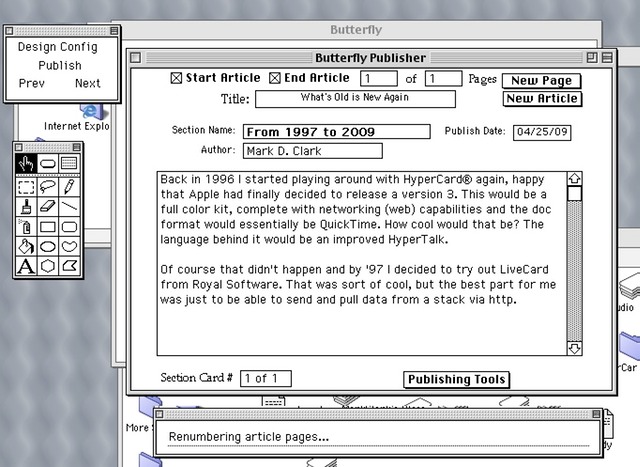Years ago I asked a friend of mine who worked in the academic computing department to help me choose a computer for a new non-profit I was putting together. This was 1989 and the PCs on campus were relatively primitive. I did most of my work on the campus VAX-11 series minicomputer and the operator had given me some decent space and permission to use BITNET. But what I really wanted was a chance to run my own computer.
Albert showed me the new SE/30 he had just purchased. The screen was B&W and small but when combined with Aldus Pagemaker it was a natural to help me put together stunning (at the time) presentations and brochures.
But what really amazed me was a program called HyperCard...
Here's a link to a 1987 Computer Chronicles report on version 1.0
In 1996 I started playing around with HyperCard again, happy that Apple had finally decided to release a version 3. This was supposed to be a full color kit, complete with networking (at least http) capabilities and the doc format would essentially be QuickTime. The language behind it would be an improved HyperTalk. Of course that didn't happen and by '97 I decided to try out LiveCard from Royal Software. The best part for me was just to be able to send and pull data from a stack via http.
At the time I thought it was too difficult to quickly jot down new thoughts, messages, etc. for posting on the web. Plus, a lot of sites didn't make use of a simple page for showing what was new since my last visit, etc. So I figured maybe a portion of a site could contain a simple set of directories for articles, indexed with a simple mechanism to show "what's new." Then again I thought it would be handy to make it easy to subscribe to certain web sites and organize them into a collection that even a child could easily manage. And so I thought I could create a "Butterfly Browser," one that grabbed specialized content from web sites, but didn't break the html standards (so any browser would do), but gave people like me who sort of missed the old "Home Stack" a way to organize one more layer (networked) of stacks to play with.
Those buttons would be iconic or custom images from the various authors, arranged on a card or a stack of cards. The stack would be the "Butterfly Collection," so to speak. Once I faced up to the fact that Apple was not going to revive HyperCard I decided it was past time to move on. It was a fun ride, and building toys and even a few serious automation systems was a snap using HyperTalk, but it was over. One thing this experience gave me was a clue as to how terrible it is to see your language die. Of course a better version of the xtalk variant was in the making, but I was busy doing other things, like everybody else.
